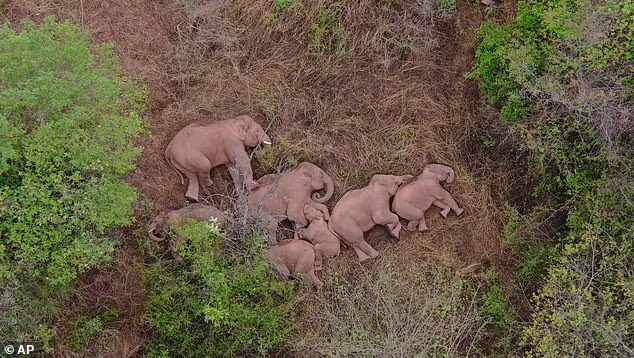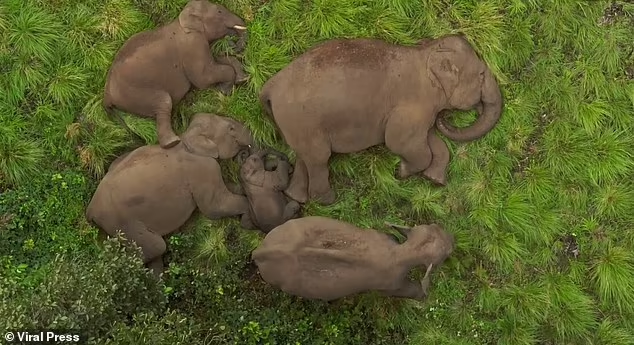Sometimes, the wild shows us what family looks like — and it’s hard not to see ourselves in it.
In the lush forests of Tamil Nadu, India, a drone camera captured something breathtaking: a herd of elephants curled up together in the long grass, forming a near-perfect ring around a tiny baby elephant sleeping safely at the center.
The footage, taken at Anamalai Tiger Reserve, shows the elephants resting shoulder-to-shoulder — their trunks tucked beneath their chins, their legs folded neatly, and their breathing slow and steady. Five elephants in total, each one varying in size, all united by one quiet instinct: to protect their youngest.
It’s one of the most tender examples of elephant family behavior ever recorded.
A Family at Rest
The elephants had chosen a soft patch of ground surrounded by dense shrubs, their earthy brown bodies standing out against the green forest.
Three of them were adolescents. One, a fully grown adult. And at the center — the smallest, likely only weeks old — nestled between the others’ massive frames.
The drone footage shows the baby fidgeting gently, twitching its ears as though lulled by the steady rhythm of the herd’s breath. One mid-sized elephant remained standing, keeping quiet watch over the group like a sentry guarding sacred ground.
Wildlife officer Supriya Sahu, who shared the video, wrote:
“Observe how the baby elephant is given first-class security by the family. The young one keeps checking the presence of others for reassurance — so similar to our own families.”
Her words struck a chord online, reminding millions that elephants, despite their strength and size, lead with gentleness.

Full Story: The Guardian with Four Paws – A Story of Love, Loyalty, and Healing
A Global Pattern of Protection
This isn’t the first time elephants have shown such careful, coordinated rest. In 2021, another herd of 15 Asian elephants in China made global headlines when drone footage captured them doing the same — sleeping in a circle, encircling their calves in the long grass.
That herd had walked more than 300 miles across Yunnan Province, leaving their nature reserve and wandering into nearby cities. Cameras followed them day and night — footage of them padding down empty streets during lockdown brought smiles to millions trapped indoors.
At one point, the exhausted herd simply stopped and fell asleep together in a field, their massive bodies curled in toward their young, trunks draped over each other like blankets.
It’s a sleeping pattern scientists say is no accident.
Elephants, especially females, live in tight matriarchal herds — grandmothers, mothers, daughters, and calves who protect one another fiercely. When they rest, they form what researchers call a “protective sleep ring.” It allows the young to stay safe in the middle while older members form a living wall around them.
Why Elephants Sleep Like This
While the sight may seem peaceful, it’s also a matter of survival. In the wild, elephants rarely sleep deeply for long stretches. They rest lightly and often take turns standing guard.
According to conservationists, the ringed sleeping formation allows them to balance vulnerability and vigilance — one of nature’s most remarkable displays of collective awareness.
The baby’s position in the middle isn’t random; it’s strategic. The youngest are always shielded from potential threats like predators or sudden disturbances.
“Even in rest, elephants remain connected,” says Sahu. “They move and breathe as one family unit.”
Also Read: The Dog Who Beat Cancer – A Reunion That Moved the World
A Mirror of Our Own Bonds
Watching the footage, it’s impossible not to notice the parallels. A mother keeping her baby close. Adolescents hovering nearby, protective but curious. The elder standing guard — patient, unwavering.
It’s the same choreography we see in human families: care, reassurance, shared rest.
When the drone camera pans out, the image is striking — a perfect circle of bodies surrounding a single heart of innocence. No fences. No instructions. Just instinct and love.
Moments like this remind us why elephants are considered among the most intelligent and emotionally complex species on Earth. They mourn their dead, remember kindness, and show empathy that rivals our own.
The Larger Story
But behind the beauty lies urgency.
Asian elephants have been listed as endangered since 1986, with their population down by nearly 50% since the early 20th century. Habitat loss, fragmentation, and human encroachment continue to push them toward crisis.
India alone is home to around 27,000 to 31,000 wild elephants, nearly 60% of Asia’s total population — but even there, space is running out.
Every serene moment like this — a nap, a newborn’s first steps, a herd’s quiet watch — is happening in a shrinking world.

More Than Just a Nap
The Anamalai footage isn’t just a cute wildlife moment; it’s a quiet sermon on unity.
Five elephants resting together, forming a fortress of care around the smallest one — a visual metaphor for what strength really looks like.
In a time where survival often demands selfishness, elephants remind us that true protection is shared.
They rest together. They rise together. They move forward together.
And somewhere in the thick green heart of Tamil Nadu, a baby elephant learned — before it could even walk far — that it was safe in the world because it was surrounded by love.



